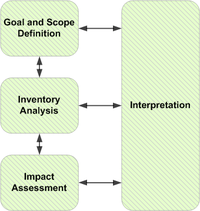
Photo from wikipedia
Abstract The use of reverse osmosis (RO) membranes has been significantly increasing because RO technology is a great option for the production of clean water for both domestic and industrial… Click to show full abstract
Abstract The use of reverse osmosis (RO) membranes has been significantly increasing because RO technology is a great option for the production of clean water for both domestic and industrial purposes, among water stress conditions and scarce clean water resources. The main solid waste from RO plants is membrane elements, which are often disposed of in landfills, and the large amount of waste needs to be properly managed. The objective of this study was to evaluate the environmental and economic gains of implementing end-of-life RO membrane recycling. The method applied the Material Input per Service Unit (MIPS) eco-efficiency tool. The recycling technique was based on chemical oxidation of thin-film-composite (TFC) RO membranes and was applied by immersion in a commercial sodium hypochlorite (NaClO). The recycled membrane showed similar performance and characteristics to porous membranes. Based on current market costs, the replacement of a new ultrafiltration membrane spiral element (with an average lifespan of 5 years) by the recycled membrane (with an estimated lifespan of 2 years) for water treatment results in monetary savings of 98.9%. MIPS indicated that chemical conversion of one 8-inch spiral element of an end-of-life RO membrane with 13.5 kg results in 2609.81 kg of materials not being polluted or withdrawn from the environment. The most important conclusion of this study is the possibility to have economic gains, associated with environmental benefits, arising from the use of recycled membranes.
Journal Title: Journal of Cleaner Production
Year Published: 2018
Link to full text (if available)
Share on Social Media: Sign Up to like & get
recommendations!